Subscribe to blog updates via email »
The best place to print your advance reader copies (ARCs) – KDP Print vs. IngramSpark vs. Barnes & Noble
ARCs, galleys, advance reader copies, or advance review copies – whatever you want to call it, you want to get your self-published book in the hands of readers in advance of your launch date. Where’s the best place to print your advance reader copies?
Where can you order ARCs?
I wondered where the best place was to print ARCs, so I ordered ARCs for my latest book, Mind Management, Not Time Management, from all three of these places:
- Amazon KDP Print
- IngramSpark
- Barnes & Noble Press (Aka “Nook Press”)
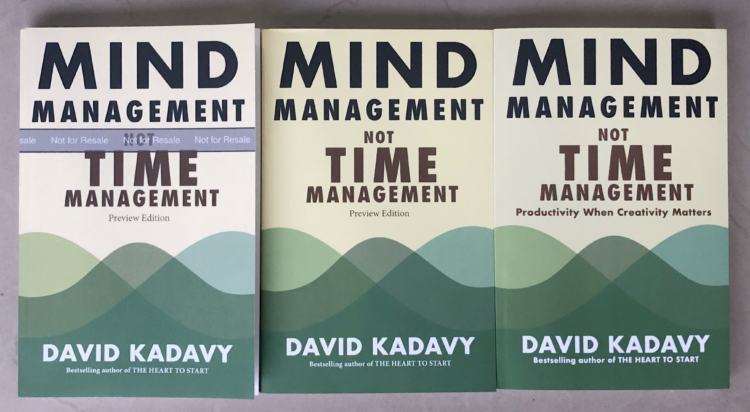
My advance reader copies (ARCs) from KDP Print, IngramSpark, and Barnes & Noble Press. (There were slight changes to the cover for B&N, but any color shifts are print variations.)
What are the “pros/cons” of each of these ARC printing options?
KDP Print
- Pros: free setup, lowest cost, simple setup (you’re probably uploading here anyway), fastest shipping
- Cons: hideous “Not for Resale” graphic, cumbersome ordering, quantity limits
IngramSpark
- Pros: no “Not for Resale” graphic, easy ordering, no quantity limits
- Cons: costly setup (though free if you get an IngramSpark promo code, more expensive unit cost, can accidentally make your book available too soon (like I did – read on), slower than KDP print and potentially slower than B&N
Barnes & Noble
- Pros: no “Not for Resale” graphic, free setup, easy ordering, no quantity limits, easy to order without accidentally making your book available, potentially faster than Ingram
- Cons: most expensive (it’s actually printed by IngramSpark, then marked up), slower than KDP Print and potentially faster than IngramSpark
Deep dive into ARCs at these three outlets
Let’s break each of those down further.

WANT TO WRITE A BOOK?
Download your FREE copy of How to Write a Book »
(for a limited time)
KDP Print ARCs
Once your paperback book is live on KDP, you can order “author copies.” But as you’re still finishing writing your book, your only option for ordering “ARCs” is to order proof copies.
KDP Print is simple for ARCs because it’s one less place to upload to
You’re probably going to upload your paperback to KDP Print anyway, so this is the simplest option.
There’s also no cost for setup, like there is with IngramSpark.
KDP Print ARCs have a big ugly “Not for Resale” graphic on them
The biggest problem with KDP Print is all of your proof copies are going to have this atrocious “Not for Resale” graphic on them:

This is fine for getting a feel for your book, or for doing what you’re supposed to do with a “proof” anyway – proofread.
But if you’re sending ARCs to influencers or anyone you’d like to have share a photo or video of the book on social media – which is probably everybody – then this is unacceptable.
Ordering KDP Print ARCs is cumbersome
Ordering these proof copies is cumbersome. First you submit a request indicating the number of copies you want to order. Then an email will arrive, within 4 hours, with a link that allows you to order them. You have 24 hours to order the proofs before the link expires.

If you’re sending ARCs to a lot of readers, this process is a pain.
KDP Print limits the number of ARCs you can order
You can order up to 5 proof copies at a time from KDP Print. Some have said that you can distribute these copies to multiple addresses, but when I was ordering I could only send to one address.
Again, this makes the process cumbersome if sending ARCs to multiple readers.
KDP Print is the cheapest option of all
For my 214 page ARC, delivered, my KDP Print proof only cost $7.30.
The same book cost $10.21, delivered, from IngramSpark.
By the time I ordered from B&N, it was 221 pages, it was $11.89 (as I’ll explain later, that price difference wasn’t from simply adding 7 pages.)
IngramSpark ARCs
When ordering ARCs from IngramSpark, you have complete control over the cover design. In other words, unlike KDP Print, there’s no “Not for Resale” graphic on the cover.
With IngramSpark you can easily order as many copies as you want
You can order as many copies as you like through IngramSpark, and the ordering process is straightforward.
I simply loaded a credit card onto my account, and gave an assistant a login to order copies. (Amazon often requests a confirmation of the full credit card number when shipping to new addresses, so you need to trust anyone to whom you delegate ordering with your full credit card number.)
IngramSpark has setup and upload fees
IngramSpark charges $49 to setup a book, and $25 per upload when revising cover or interior.
Since you’re ordering an ARC, you’re of course going to re-upload the contents at least once more, when you’ve put the finishing touches on your book. And if you want to frequently update your ARC as you approach launch, this could really add up.
Note that The Alliance of Independent Authors offers a coupon code to their members which waives these fees entirely. So, a membership can quickly pay for itself.
IngramSpark printing costs more than Amazon KDP
My IngramSpark ARC was $10.21, delivered. From KDP Print, the same book was only $7.30. (Remember, this is for a paperback. An IngramSpark hardcover is much more expensive – though hardcovers aren’t even available through KDP Print.)
Don’t accidentally make your IngramSpark book available too soon (like I did!)
It wasn’t until I shared my experience of ordering ARCs on the Reddit self-publishing community that someone pointed out to me that even if the release date for your book hasn’t arrived, bookstores can order your IngramSpark book if you make it available for shipping.
To order an ARC, I had to approve the book. It makes sense in retrospect that stores could then order the book, but this is how the self publishing adventure goes – you live and learn. I was just eager to get my book to readers.
Theoretically, a bookstore could have ordered my book in advance of the release date, and ended up stocking their shelves with a very much in-progress version of my book. However, you have to be a pretty big name for that to happen. Even with 50,000+ books sold to my name, I don’t think this happened.
Another bad thing about making your book available through IngramSpark: They send all the metadata to stores, such as Amazon. And that metadata, on Amazon at least, includes a “Look Inside” preview of your not-finished book. Again, you have to have lots of people looking out for your book for this to be much of a problem. This didn’t bother me a lot when I noticed it.
How to order copies without releasing your book on IngramSpark
Thanks to this post, I realized you can order ARCs on IngramSpark without making your book available.
As you’re setting up your book, you need to choose the “print only” option, then choose a free for a non-distributable SKU. So you’re essentially setting up a book just for yourself.
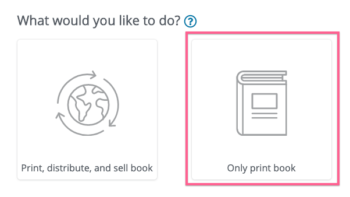
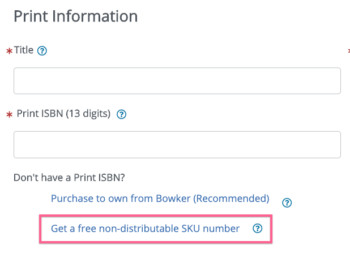
I haven’t tried this, but apparently you can later call – and have to call – to have it changed to a distributable book, with your ISBN. If you hate calling companies on the phone as much as I do, this may be a dealbreaker.
Slow shipping with IngramSpark?
It took insanely long for my books to print and ship with IngramSpark. One book took seven weeks, and several took a month. IngramSpark did warn of printing delays due to COVID, so this was a factor. However, even the fastest shipping I had with IngramSpark took several days longer than my KDP Print proof.
Since, as I’ll show you in a bit, Barnes & Noble Press books are printed by Ingram, I have a theory your books may take priority – in the case of printing delays – if you print with Barnes & Noble. I’ll explain why in the next section.
Barnes & Noble (aka Nook Press) ARCs
The easiest to order and hardest to mess up option was Barnes & Noble Press.
Barnes & Noble Press books are printed by IngramSpark
I noticed something on the packing slip for the ARC I ordered from Barnes & Noble Press:
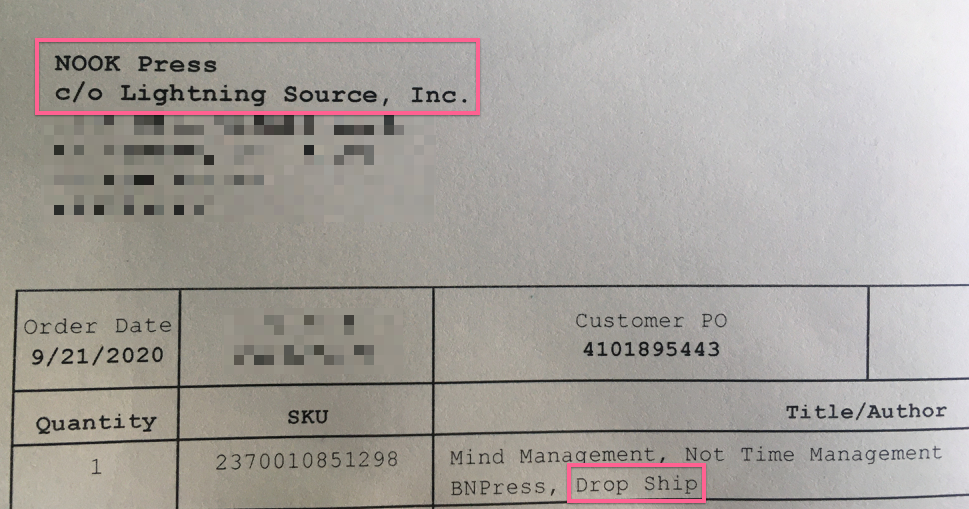
See where it says “c/o Lightning Source”? Lightning Source is a printing and distribution unit of IngramSpark.
Notice also that under “Title/Author” it says “Drop Ship.” Drop shipping is when one company sells a product, and a different company delivers it.
So, Barnes & Noble Press books are printed on the same network of printing presses as IngramSpark books. At least the book I received was.
Knowing this helps us understand a couple things.
Barnes & Noble Press ARCs are the most expensive
Since IngramSpark is printing B&N books, B&N books are a little more expensive than IngramSpark’s. It looks like B&N is paying IngramSpark, and adding a little charge on top to make a profit.
My final 262-page 5.5” x 8.5” paperback costs around $12.50, delivered within the U.S. through B&N. It’s about $11.10 through IngramSpark, and $8.20 through KPD Print.
Barnes & Noble Press may print faster
The books I ordered from IngramSpark sometimes took incredibly long to print and ship. One book I ordered on July 28th didn’t print and ship until September 8th. It then arrived at its destination in Oregon September 17th. That’s more than seven weeks!
The books I ordered from Barnes & Noble did not take as long. Most arrived within about two weeks, and some in only five days.
Granted, there were printing delays due to COVID, and I ordered the Barnes & Noble books later than I ordered the IngramSpark books, and IngramSpark’s books started shipping faster after a while. But I have a theory, and it’s just a theory:
Imagine you’re IngramSpark. For whatever reason, you have more books to print than you have capacity to print them on-schedule. You have printing delays.
Who would you rather piss off? Barnes & Noble, probably one of your biggest customers, or Helen, the 67-year-old retired secretary from Omaha, looking forward to receiving a proof of her first sweet romance novel?
Helen seems sweet and I’d hate to disappoint her. But I’m a person and IngramSpark is a business. They don’t want to piss off a big customer such as Barnes & Noble.
Just a theory, but if there are printing delays, time is of the essence, and I don’t mind paying a buck or so extra, I’d rather order through Barnes & Noble than IngramSpark.
Barnes & Noble Press has no setup nor upload fees
Barnes & Noble prints on IngramSpark’s network, but interestingly, there are no setup nor upload fees on B&N like there are on IngramSpark.
This could make the extra unit-costs of B&N actually end up cheaper, depending upon your plan.
Barnes & Noble Press has an easy-to-use interface
Barnes & Noble’s interface was more attractive than IngramSpark’s, and easier to use. Which explains why I didn’t accidentally make my book available in their interface, like I did in IngramSpark’s.
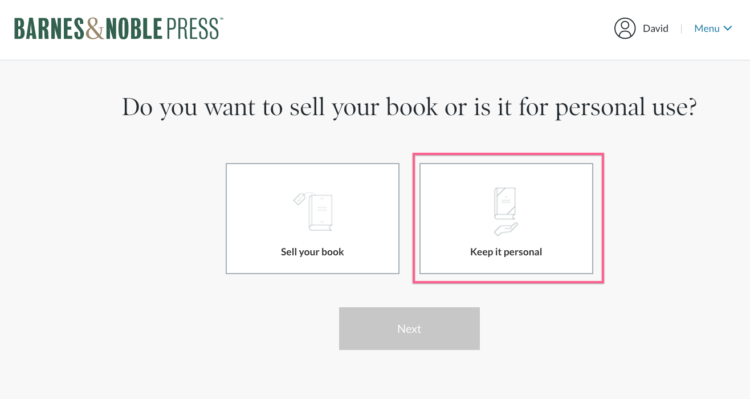
I chose those “personal” book option, which I guess is the equivalent of choosing IngramSpark’s “print only” option.
Final caveat: You’ll need a different cover graphic for IngramSpark (or B&N) than for KDP Print
If you only plan to distribute through Amazon, and are considering ordering ARCs through IngramSpark or Barnes & Noble Press, consider that you technically should have a different cover graphic for IngramSpark or B&N Press books than you’d have for KDP Print.
This is because IngramSpark (and thus B&N) print on thinner paper than KDP Print (at least this was my experience with the 50 lb. cream stock paper. YMMV.)
Since the paper is thinner, the book is thinner. Since the book is thinner, your cover should be slightly different.
This may be a subtle difference if you have a thin book. I never noticed with my 140-page The Heart to Start: Stop Procrastinating & Start Creating. But with the 212-page ARCs of Mind Management, Not Time Management, the difference was unmistakable.
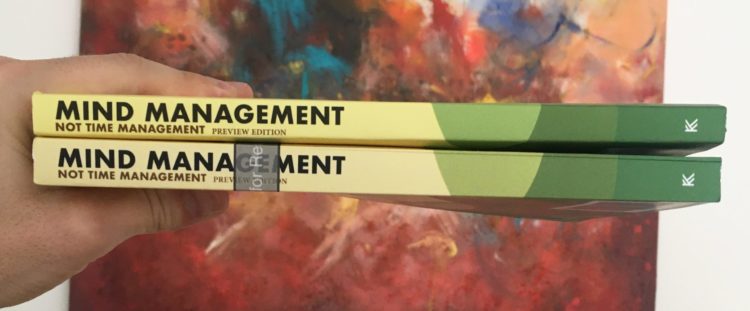
IngramSpark (top) and B&N Press use thinner paper than KDP Print (bottom), so be prepared to have a slightly-adjusted cover graphic.
If you don’t make different cover graphics, the graphics on your spine will be off. You may decide you don’t mind, but otherwise, it’s extra work and potentially expense to have different cover graphics.
So, where’s the best place to order advance reader copies?
Now that I’ve ordered from these three places, where will I order advance reader copies?
- For cheap advance copies for proofreading, I’ll use KDP Print.
- To get books to advance readers, I’ll use IngramSpark (with a non-distributable SKU!)
- If there are printing delays, I’ll use Barnes & Noble Press, in the hopes the book will print faster.
I hope you found that helpful. If you liked this write-up, you’ll probably love my monthly author income reports.


